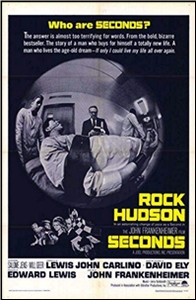Search Results for 'suspense'
Did you find what you wanted ?
Sat 20 Feb 2010
A TV Review by MIKE TOONEY:
“One Tiger to a Hill.” An episode of Kraft Suspense Theatre (Season 2, Episode 8). First air date: 3 December 1964. Barry Nelson, James Gregory, Diane McBain, Peter Brown, Warren Stevens. Writer: Robert Hamner. Story consultant: Anthony Boucher. Director: Jack Arnold.
When $400,000 worth of valuable jewels are stolen, Lieutenant Wade (James Gregory) is certain who did it, his constant adversary cat burglar Colin Neal (Barry Nelson). But at the same time the theft occurs, Wade is enjoying some fine wine with Neal and his girlfriend Diana (Diane McBain) in a swanky restaurant, giving Neal an ironclad alibi.
Lieutenant Wade knows Neal must be behind this somehow; what he doesn’t know is that Neal, well aware of the close police scrutiny he is under, has been training an apprentice, Chris (Peter Brown), to steal for him.
But what even Neal doesn’t know is that his girlfriend has been seeing Chris on the side — and that Chris has plans for the loot that don’t include Neal. When Neal does become aware of these developments, however, he is moved to take action. How does the old saying go? You must set a thief …
… To Catch a Thief, Hitchcock’s 1955 thriller, was undoubtedly the inspiration for this one. (And any instances of ingenuity you may detect in the storyline are most probably due to story editor Anthony Boucher, who excelled at this sort of thing.) The police lieutenant and the master thief are the best of enemies, each one having grudging respect for the other.
Barry Nelson’s criminous credits include Eyes in the Night (1942), Casino Royale (1954, as the very first screen James Bond), The Borgia Stick (1967), and appearances on Nero Wolfe (1981) and Murder, She Wrote (1988).
James Gregory appeared in nearly 200 TV shows and movies, including Naked City (1948), The Lawless Years TV series (1959-60), The Manchurian Candidate (1962), the lousy Dean Martin “Matt Helm” film series (1966-67), Columbo (1972), Police Story (1974-75), Detective School (1979), and a long run on the Barney Miller series (1975-82).
Unlike Nelson and Gregory, Peter Brown is still with us. His longest-running involvement with TV has been in Western series: as a deputy marshal on the serious Lawman (1958-62) and the humorous Laredo (1965-67).
Thu 11 Feb 2010
A TV Review by MIKE TOONEY:
“The Jack is High.” An episode of Kraft Suspense Theatre (Season 2, Episode 6). First air date: 19 November 1964. Edd Byrnes, Pat O’Brien, Henry Jones, Larry Storch, Harry Bellaver, William Bramley, Michael Macready, William Boyett. Writer: William Wood. Director: Ralph Senensky.
“What we have here,” says Inspector Dan Zarilla (Pat O’Brien), “is an alliance of losers wanting to get into the Win column.” He’s referring to a band of misfits who have successfully pulled off an armored car robbery in Nevada, netting $3 million.
The heist was masterminded by a man who prefers to be called The Professor (Henry Jones), with the help of a dishonorably-discharged ex-Marine (Edd Byrnes), a not-so-funny standup comic (Larry Storch), a technician (Harry Bellaver), and the only professional criminal in the bunch (William Bramley).
The Professor has purchased a gasoline tanker truck to use in the getaway; it will act as something of a Trojan Horse as they make their way west towards Los Angeles. To complete the illusion, The Professor has had the technician weld a false bottom in the tank, leaving enough space for 2,000 gallons up top to act as ballast and to fool the cops in case they’re stopped.
But this “alliance of losers” simply can’t get along, especially the ex-Marine and the professional criminal; plus, the technician has a heart problem he’s told no one else about; some of the welds inside the tank are not exactly tight; not to mention the dogged pursuit by Inspector Zarilla; so that ultimately The Professor’s beautifully-planned caper begins to unravel ….
I saw this one just the other evening for the first time in nearly half a century — and in color. I didn’t remember all the story developments, but I had never forgotten the final scene after all this time, a finale that’s even more effective here than it was in black and white.
The hollowed-out tanker truck is a direct lift from James Cagney’s White Heat (1949). At one point, during a roadblock stop, Storch, in order to divert a highway patrolman’s attention, launches into several fairly bad imitations of Hollywood stars, including Cagney — which may have beeen intended as a double inside joke because of White Heat and the fact that Pat O’Brien was often teamed with Cagney in Warner Brothers ’30s gangster films.
In this one, however, O’Brien comes across less as a high-octane minion of the law and more like Inspector Maigret, laid-back but persistent.
Edd Burns will always be remembered as Kookie in the 77 Sunset Strip TV series (1958-63). Pat O’Brien had a huge career, including Angels with Dirty Faces (1938), Having Wonderful Crime (1945, as Michael J. Malone), Crack-Up (1946), Riffraff (1947), the failed pilot for The Adventures of Nick Carter (1972), and many others, including Ragtime (1981, with Cagney).
Henry Jones was all over films and TV: 3:10 to Yuma (1957), Vertigo (1958, as the coroner), five appearances on Alfred Hitchcock Presents, and a continuing role on Mrs. Columbo (1979-80). You might remember Larry Storch as Corporal Agarn in F Troop (1965-67).
Mon 8 Feb 2010
A TV Review by MIKE TOONEY:
“Leviathan Five.” An episode of Kraft Suspense Theatre (Season 1, Episode 14). First air date: 30 January 1964. Arthur Kennedy, Andrew Duggan, John Van Dreelen, Harold J. Stone, Frank Maxwell, Robert Webber (prosecutor), Frank Overton (the defense), Judson Laire. Teleplay: Berne Giler, David Giler, and William P. McGivern. Story: Berne & David Giler. Director: David Lowell Rich.
Four men are standing trial for murdering another man. All five had been working in a high-security installation 1,500 feet underground when an earth displacement blocked the elevator and airshafts to the surface. Being scientists, they start calculating how long they have to live before help arrives.
No matter how they figure it, unless one of them dies they’ll all suffocate. When it is suggested that someone could sacrifice himself (they have a gun) if he draws the short stick, one man refuses on moral grounds to be part of any plan involving suicide.
The group then devises another approach — whoever is selected won’t kill himself but instead will wait until everybody has retired from the main area (to conserve air), fetch the revolver, and go to another man’s cubicle (chosen at random), where he will shoot that person, return to the common area, wipe the gun clean of prints, go back to his own cubicle, and pretend innocence.
And so it comes to pass — except, as we learn later, the man who dies was not chosen at random ….
This description makes the play sound like a whodunit, which it is — but, at the same time, it isn’t. The main thrust of the story is to explore such heavyweight ideas as: What is the difference between murder and execution? Can five men behave as a sovereign nation, making their own laws and deciding who lives and who dies?
If a man consents to sacrifice himself, can his death at someone else’s hand be deemed a murder? If one man commits murder, can three other men who never wielded the weapon be held equally responsible? Isn’t this a nation “under God” and His laws?
As I say, ponderous matter for a one-hour TV drama; yet the script smoothly proposes them all without bogging down in pointless moralizing.
Although it’s never mentioned in the play, the term “leviathan” in the title must be a reference to English political philosopher Thomas Hobbes’ dubious conception of government: “For by Art is created that great Leviathan called a Commonwealth or State (in latine Civitas) which is but an Artificial Man; though of greater stature and strength than the Natural, for whose protection and defence it was intended; and in which, the Sovereignty is an Artificial Soul, as giving life and motion to the whole body ….”
Fri 29 Jan 2010
A TV Review by MIKE TOONEY:
“The Rise and Fall of Eddie Carew.” An episode of Kraft Suspense Theatre (Season 2, Episode 30). First air date: 24 June 1965. Dean Jones, Sheilah Wells, Alan Hewitt, Jerome Cowan, Harry Townes, Ken Lynch, Stanley Adams, Ian Wolfe, John Hubbard, Barry Kelley. Story: Robert Thom; adaptation: Don Brinkley. Director: Joseph Pevney.
“Alas, that love, so gentle in his view, should be so tyrannous and rough in proof.”
— Romeo and Juliet
Senile nonagenarian Ellis Stone (Ian Wolfe) manages to get himself locked in the vault of his own bank; unless he’s very good at holding his breath, by the time the electronic lock opens the door three days hence he’ll be very dead.
The bank manager, in full panic mode, phones Sam Becker (Jerome Cowan), the public relations man for “our party.” He immediately sees the PR disaster (not to mention the financial catastrophe) that he and his cronies would suffer if dotty old Stone, a million-dollar-a-year party contributor, were to go toes up.
In a moment of inspiration, he plumps for making use of the talents of Eddie Carew (Dean Jones), “The Human Can Opener,” currently serving time in the state pen.
But Dr. Farley (Harry Townes), the prison psychiatrist, has been making progress weening Eddie away from his compulsion to steal and is flatly opposed to letting Eddie anywhere near piles of money. It would be, as he says, like having an alcoholic become a wine taster.
The prison warden (Alan Hewitt) overrules the doctor, however, and takes Eddie to the bank. Before he goes, Eddie tries to warn everyone of what could happen; but even his girlfriend, Sally McClure (Sheilah Wells), encourages him to do this because she has faith in his rehabilitation.
Eddie is now in a position to call the shots: no prison uniform (“something in charcoal gray” would be nice) or handcuffs, deciding who can be present when he does the job (others can be a distraction), and especially having “the best jelly man in the business,” Pinky Ferguson (Stanley Adams), assist him.
Yes, you guessed it: Eddie has ideas that go way beyond rescuing the old guy, which he almost betrays when he first lays eyes on the safe. (“Well,” says Becker, “is he going to open it or make love to it?”)
What Eddie doesn’t know is that before the sun rises he will have to crack this same safe three times: once out of greed, once out of duty (and self-interest), and once out of love ….
This one has a great comic cast as well as normally serious actors doing a humorous turn. Dean Jones is well-known for the many Disney films he’s appeared in. Stanley Adams always seemed to be an affable fast-talker just on the other side of the law (e.g., Cyrano Jones in the immensely popular Star Trek episode “The Trouble with Tribbles”).
And Ken Lynch must have played a cop hundreds of times over the years. Jerome Cowan was a low-rent version of William Powell; he could do light comedy (Gomer Pyle, U.S.M.C.), but most movie fans remember him as Miles Archer in The Maltese Falcon and the spineless architect in The Fountainhead.
Tue 19 Jan 2010
A TV Review by MIKE TOONEY:
“Twixt the Cup and the Lip.” An episode of Kraft Suspense Theatre (Season 2, Episode 27). First air date: 3 June 1965. Larry Blyden, Charles McGraw, John Hoyt, Ethel Merman, Jean Hale, Joan Blackman, John Harmon, Lee Patterson, Lane Bradford. Teleplay: Don Brinkley; based on a story by Julian Symons (Ellery Queen’s Mystery Magazine, January 1965). Director: Leon Benson.
Imagine being fired for being too honest. That’s what happens to Lester Pennell (Larry Blyden), however, when Mr. Orbin (John Hoyt), his boss at an up-scale art gallery, catches Lester being too forthcoming about the value of an item they’re displaying for the French government: a silver sceptre once wielded by Louis XIV. Mr. Orbin and the French say it’s worth $2 million; Lester says it couldn’t be worth a penny over $1.5 million — tops.
Not only has he been given his two weeks’ notice but Larry also has a falling out with his girl Lucille (Joan Blackman), who accuses him of being a “doormat.”
Meanwhile, back in Lester’s apartment house his neighbor across the hall, Nick Stacey (Charles McGraw), has stolen two rare books from Lester. Nick, you see, is an ex-cop who got caught taking bribes and is presently, as he says, “at liberty.” (How he missed jail time for his graft is never explained.)
Down the hall Clara Lovelace (Ethel Merman) and her daughter Lambie (Jean Hale) are under-employed actors waiting for a job.
Lester is in a dark mood when he catches Nick with his stolen books, dark enough indeed to see how Nick can be of enormous help in exacting revenge on Mr. Orbin. Lester is intimately familiar with the security systems at the gallery — and that silver sceptre just seems to be begging to get ripped off.
And so Lester evolves a shaky caper that involves Nick and his fence, Pogo (John Harmon), Clara, Lambie, and himself. When you consider that they never have a chance to do a full rehearsal of the robbery because the French ask for the sceptre back days sooner than expected and that Nick and Lambie have ideas of their own for the boodle, you may have already concluded this caper won’t go off anywhere near as planned ….
However, while you might anticipate the outcome of this one, I seriously doubt you’ll be able to foretell exactly what happens in the fourth act — and why.
Larry Blyden was a regular fixture on American TV in the ’50s and ’60s, playing amiable yet somehow sinister characters; he also hosted several daytime game shows. He appeared in a couple of episodes of Twilight Zone, one where he winds up in Hell and another in which he’s a ham actor in a TV Western who gets an education from a real cowboy. Blyden even won a Tony Award on Broadway.
Gruff and gravelly-voiced Charles McGraw is the legendary film noir star (T-Men, Border Incident, Armored Car Robbery, The Narrow Margin, etc.) who could also register integrity if the role called for it (The Bridges at Toko-Ri). He and Ethel Merman appeared together in It’s a Mad Mad Mad Mad World two years earlier.
Always dependable character actor John Hoyt’s career stretched from the ’40s to the ’80s. He could handle comedy or drama equally well. Science fiction fans may remember him from When Worlds Collide, in which he played a devious, wheelchair-bound billionaire, and as the friendly doctor in the first Star Trek pilot film.
Julian Symons, upon whose story this show is based, is famous — or infamous, depending on your viewpoint — for the opinions he expressed in his critical survey of mystery fiction, Bloody Murder (a.k.a. Mortal Consequences).
Fri 8 Jan 2010
A TV Review by MIKE TOONEY:
“The Name of the Game.” An episode of Kraft Suspense Theatre. First air date: 26 December 1963 (Season 1, Episode 10). Jack Kelly, Pat Hingle, Nancy Kovack, B. G. Atwater, Steve Ihnat, Monica Lewis. Story: Fred Finklehoffe; screenplay: Frank Fenton. Director: Sydney Pollack.
Don’t confuse this single show with the later TV series. The name of the game here isn’t fame but winning and losing at gambling, specifically casino craps.
Jack Kelly plays an expert gambler who is down on his luck. Along comes Pat Hingle as an over-eager, impulsive Texas oil millionaire (he says he’s worth $10 million) anxious to beat the house at its own game.
Hingle wants to win $200,000 and split it 50-50. Kelly agrees to team with Hingle as long as he does exactly what Kelly directs him to do. “I don’t tell you how to make oil wells,” Kelly informs him, “and you don’t tell me how to gamble.” Chafing at the restrictions, Hingle reluctantly assents.
Kelly warns his partner that the odds always favor the house and that he may have to pony up at least a million to win that two hundred grand, but Hingle doesn’t seem to care. And thus begins a marathon bout of gambling, with Kelly having to rein in Hingle now and then. Director Sydney Pollack has one long-duration shot from directly over the craps table looking straight downward — a “God’s eye view” of the action.
It’s a long, hard slog but Kelly and Hingle finally do clear two hundred thousand. Hingle, however, is hot to double his winnings. Kelly, reminding his partner of their agreement, says it’s time to quit. He’ll be expecting his hundred grand after Hingle cashes in their chips. Kelly leaves the casino to see a girl he has just met (Nancy Kovack) and hopefully extend their romantic relationship.
But Hingle is angry, accusing Kelly of being a penny-ante gambler and not the “player” Kelly fancies himself to be. Hingle is determined not to give his partner his cut, even if it means a fight ….
But that’s not the end of it. There is a fine little twist in the story near the end where Kelly learns a valuable life lesson in the school of hard knocks.
Although under an hour in length, “The Name of the Game” has a movie “feel” to it. There’s some nice misdirection in the plot, and the performances are uniformly convincing.
Trivia: Knowledgeable sci-fi TV fans will recognize several familiar faces here. Nancy Kovack starred as a temptress in one Star Trek episode. From the same series, B. G. Atwater (later commonly billed as “Barry”) played the founder of the logical Vulcan civilization, and Steve Ihnat was a psychotic starship captain who insisted on being called “Lord” or bad things would happen.
In a minor but memorable bit part, Grace Lee Whitney plays a statuesque blonde whose luck with the dice waxes but rapidly wanes; she had a continuing role as Yeoman Rand on Star Trek. And of course Jack Kelly played the impetuous young executive officer of the deep space cruiser C-57D who is torn to bits by the Id Monster in Forbidden Planet (1956).
Sun 5 Jul 2009
FIRST YOU READ, THEN YOU WRITE
by Francis M. Nevins
I was nine years old in 1952 when my parents bought their first TV set. Being a little young at the time, I never watched what was perhaps the leading crime-drama anthology series of the early Fifties, CBS-TV’s Suspense, which had been heard on radio for almost a dozen years and debuted on the small screen early in 1949.
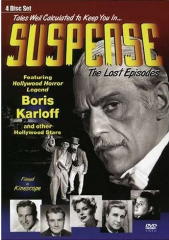
Just recently, however, I’ve begun to catch up, thanks to the release of three DVD sets containing several dozen episodes, including some of the earliest.
One of these, “Help Wanted” (June 14, 1949), was based on “The Cat’s-Paw,” the second published short story of the soon to be legendary Stanley Ellin (1916-1986),which had just appeared in the June 1949 issue of Ellery Queen’s Mystery Magazine.
A few evenings ago I ran this episode and then re-read the story. Both deal with a middle-aged unemployed loner named Crabtree to whom an anonymous party offers $50 a week (a generous salary in those days) to sit in a tiny office on the top floor of a skyscraper, eight hours a day six days a week, and compile useless financial reports.
Later Crabtree’s benefactor pays him a visit and offers him life tenure, as it were, if he’ll push his next visitor out the office window. Here is where Ellin and the writers of the TV version (Mary Orr and Reginald Denham) part company. In the story Crabtree follows through, although offstage (because Ellin almost never shows an act of violence), and gets away with it because his employer has made the death look like suicide.
On the air, whose censors looked askance at unpunished crimes, the visitor falls out of the window accidentally because of his paranoid fear of the office cat, and the intended murder is impliedly brought home to Crabtree’s Iago because the victim was the wrong man, not a blackmailer but a harmless crackpot soliciting money for a campaign to bring back Prohibition.
Otto Kruger played Crabtree, and Douglas Clark-Smith, who gives the impression of having been drunk on camera, was “Mr. X”.
This live drama, directed by Robert Stevens, was the first of at least fifteen live or filmed TV adaptations of Ellin stories. The same tale, translated to film with the same title and a script based on this one, later became the basis of an episode of Alfred Hitchcock Presents (April 1, 1956), with John Qualen and Lorne Greene in the roles of Crabtree and his employer and James Neilson directing.
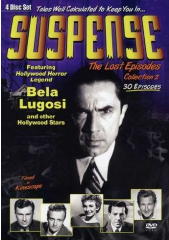
Also on Disc One of Collection One from Suspense is “The Murderer” (October 25, 1949), based on Joel Townsley Rogers’ often anthologized short story of the same name (Saturday Evening Post, November 23, 1946).
The story begins just after dawn on a lonely meadow, probably in the same general area where so much of Rogers’ powerful suspense novel The Red Right Hand (1945) was set. Farmer John Bantreagh discovers the dead body of his sluttish wife, knocked unconscious and then deliberately run over by a car.
Then deputy Roy Clade drives up, and the dialogue between the men heightens our suspicion that Bantreagh himself is the murderer. These two are the only onstage characters in Rogers’ story.
In the Suspense version, directed by Robert Stevens from a Joseph Hayes teleplay, Jeffrey Lynn and John McQuade played Bantreagh and Clade but there are also several other characters who in Rogers’ story were only referred to in the dialogue.
This tale was never adapted for Alfred Hitchcock Presents but did become the basis of a later live version on ABC’s Star Tonight (March 17, 1955), with Bantreagh and Clade played by Charles Aidman and Buster Crabbe.
During my three years at NYU Law School I watched very little TV, but in the fall of 1967, when I was still living in Greenwich Village and waiting for the results of the bar exam (yes, I passed), a new series debuted on ABC which, with its tension and its reflection of the turbulence of the Vietnam and Black Power years and its abundant action scenes shot on the streets of New York, captivated me instantly.

N.Y.P.D., starring Jack Warden as tough detective lieutenant Mike Haines, Robert Hooks as black plainclothesman Jeff Ward and Frank Converse as newbie Johnny Corso, was directed and scripted for the most part by veterans of the golden age of live teledrama and lasted two full seasons.
Looking over the cast lists recently, I was amazed at the number of actors then based in New York who appeared in one or more episodes and went on to household-name recognition and in some cases superstardom.
In alphabetical order and limiting myself to males: John Cazale, James Coco, William Devane, Charles Durning, Robert Forster, Vincent Gardenia, Charles Grodin, Moses Gunn, James Earl Jones, Harvey Keitel, Tony LoBianco, Laurence Luckinbill, Al Pacino, Andy Robinson, Mitchell Ryan, Roy Scheider, Martin Sheen, Jon Voight, Sam Waterston, Fritz Weaver.
Fewer female cast members made it big, but among those that did were Jill Clayburgh, Blythe Danner and Nancy Marchand.
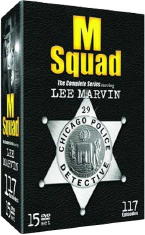
None of these names were familiar to me 40-odd years ago except James Earl Jones, whom I’d seen in an off-off-Broadway production of Othello, but today they’re instantly recognizable by millions. Why this superb series hasn’t been revived on DVD is a mystery; the fact that it hasn’t is a shame.
Speaking of vintage TV cop shows, M Squad, starring Lee Marvin, is now available on DVD, the complete 115-episode series for around $120. That’s pretty steep even if you buy the set with a 40% Borders Rewards discount coupon, but many who were teens during its first run as I was will be sorely tempted.
Mon 22 Apr 2024
Posted by Steve under
Reviews[2] Comments
REVIEWED BY DAVID VINEYARD:
PAUL GALLICO – Too Many Ghosts. Doubleday, hardcover, 1959. Pocket/Cardinal #C-426, paperback, 1961. Intl Polygonics Ltd, softcover, 1988.
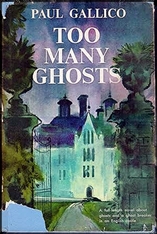
Lord Paradine was running short of funds to keep Paradine Hall open in the Post War economic slump in the United Kingdom so it seemed like a good idea to open up part of the place as a sort of residential country club to invited guests and residents, but some uninvited guests of the kind that play strange harp music, blow out candles, make weird noises in the night — including a nebulous nun — are now sharing the digs and something has to be done.
That’s when Sir Richard Lockerie, who went to Cambridge with a curious fellow, recalls his old friend Alexander Hero. Hero is a sort of private detective of the supernatural, doing psychical research with the aid of science; in short, ghost-busting and doing quite well at it in Post War England.
Alexander Hero featured in two novels by Paul Gallico, this and The Hand of Mary Constable, in which Hero investigates Professor Constable’s haunting by his dead daughter, plus suspiciously competent mediums, and a Russian plot to convince him to defect. When filmed in the US as a made-for-television movie titled Daughter of the Mind, the venue moved to this country. Don Murray played Hero and was hired by Fed Ed Asner to prove what Ray Milland was seeing wasn’t his daughter’s spirit.
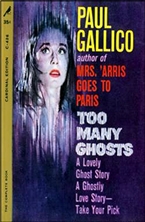
Even if you are largely unaware of Alexander Hero, you likely have heard of his housekeeper, Mrs. Harris, or as she says in her Cockney accent, ’Arris, who you might have recently followed on her trip to Paris, and in other adventures to New York, Rome, and even Parliament. It is a rare occasion of Mrs. Hudson outshining (and selling) Mr. Holmes.
Paul Gallico’s rather remarkable career began as a noted sports writer, his book on Lou Gehrig filmed as Pride of the Yankees with Gary Cooper. In fiction he started out pretty strong with the elegiac haunting wartime tale, The Snow Goose, moved on to the popular Adventures of Hiram Holliday in the slicks and an early television series with Wally Cox, The Small Miracle, Ludmilla, Coronation, the basis for the film Lily, Thomasina, The Abandoned, the Cold War thriller Trial by Terror (filmed as Assignment Paris), the best-selling The Boy with the Bubble Gun, The Zoo Gang (which became a television series), and among others something called The Poseidon Adventure and Beyond the Poseidon Adventure. Ten of those were either filmed or made into television series, not counting short stories adapted on screen.
Brilliant, high handed, and with an eye for the ladies, Alexander Hero is pretty much a Great Detective, and while the books flirt with the supernatural they tend to come down hard on rational explanations of supposed miracles, quite human villainy, and for all the chills and suspense, logical solutions to impossible mysteries.
Too Many Ghosts is a classic manor house mystery of the Golden Age variety where haunting and not murder is the game afoot, though Gallico makes the stakes just as high, and those not fond of the supernatural in mystery fiction may enjoy it in that Gallico has it both ways in terms of detection and thrills while still keeping both feet on the ground.
Thu 11 Apr 2024
A 1001 MIDNIGHTS Review
by Newell Dunlap
DAVID ELY – Seconds. Pantheon, hardcover, 1964. Signet P2507, paperback, 1964. Harper Voyager, softcover, 2013. Film: Paramount, 1966 (director: John Frankenheimer).
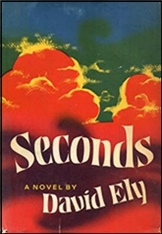
A prosperous banker leaves his New York office at noon, knowing full well he may never see it again. Following an address on a slip of paper, he takes a cab to a run-down laundry in a slum area of the city. From there. he is directed to a warehouse. From the warehouse. he is taken in the back of a truck to a large office building, and it is here the transition process begins.
For the banker (soon to be a painter known as Wilson) has elected literally to change his life and be “reborn” as a new man. A surgically altered cadaver shows up in a hotel room and the banker is officially pronounced dead of a heart attack. Meanwhile, we follow Wilson through his own surgical alterations, and before you know it, he has been relocated to California and lo the life of a single. moderately successful painter.
Wilson cannot relax and enjoy himself, though. His new life strikes him as shallow and meaningless, and he feels an overwhelming desire to visit his wife and daughter. This he does, going against numerous warnings from representatives of the company that gave him his new identity. The company, it seems, creates about 3000 new identities each year, so it has a stake in seeing that no one jeopardizes its operation. Obviously Wilson is one of those people who will never make the transition properly, so he is brought back for further “processing.”
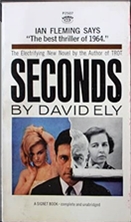
Few books can match the suspenseful beginning of Seconds, as the reader wonders what in the world is going on. The suspense tapers off when we learn what is going on. but increases again as we begin to wonder what the company will do with the renegade Wilson. As it turns out, Wilson is not the only man who has made an unsuccessful transition-and from a business standpoint, the company’s disposition of these failures makes perfect sense.
This unusual and nightmarish novel was made into an equally suspenseful John Frankenheimer film in 1966, with Rock Hudson and Salome Jens.
David Ely has made a career of producing offbeat suspense fiction, both novels and short stories for Ellery Queen’s Mystery Magazine and such slick magazines as Cosmopolitan. (One of his Cosmo stories, “The Sailing Club,” was the recipient of the 1962 Best Short Story Edgar.) Among his other novels are Trot ( 1963), The Tour (1967), Poor Devils (1970), and the eerie Mr. Nicholas (1974).
———
Reprinted with permission from 1001 Midnights, edited by Bill Pronzini & Marcia Muller and published by The Battered Silicon Dispatch Box, 2007. Copyright © 1986, 2007 by the Pronzini-Muller Family Trust.
Fri 29 Mar 2024
Posted by Steve under
Reviews[5] Comments
REVIEWED BY DAVID VINEYARD:
MICHAEL MANN & MEG GARDINER – Heat 2. William Morrow, hardcover, August 2022; softcover, January 2024. Novelization of forthcoming sequel (in development?) to the film Heat (Warner Brothers, 1995; directed by Michael Mann).
This.
Is.

A sequel, by director Michael Mann, and by successful suspense novelist, Meg, Gardiner, to the popular crime film, Heat starring. Robert de Niro, Brad Pitt, and Al Pacino,
Okay, sorry, I won’t write all of the review in the style of the book. Unfortunately, unlike this book, I have some vague idea what syntax means and how sentences are constructed.
If you have a copy of this book you have seen the rave reviews it received.
I have no idea what these people were smoking.
Heat 2 picks up where the film ends. Ghris Shiherlis (Brad Pitt) is wounded and hiding out in Koreatown hallucinating from his wounds and oxycodone while policeman Vince Hanna (Al Pacino) is hunting him. Neil McCarthy (Robert de Niro) is dead, but that won’t keep him out of the novel (I use the word reservedly) which switches back and forth from seven years before the events in Heat to now.
The novel is written in a stream of consciousness fragmented jagged present tense voice that amounts to 613 page of nails on the blackboard prose. Reading it is as close to recreating the pain I used to suffer with Cluster Headaches as I hope to ever experience.
You may want to borrow one of the oxycodone tablets Chris Shiherlis keeps popping, but honestly I don’t think drugs would help, though this book often reads as if it was written on them.
I’m not going to go into the plot. Instead I’ll just quote a few short bits.
Before I start you may want to find a bullet to bite on.
Chris head swam.
My cut from the bank heist…
Will be safe. I’ll set up an account from a Delaware trust. You can access it by phone, fax, computer. But where you’re going, don’t draw on that money unless it’s an emergency. No flash. You can’t stick out.
I need to get some of it to Charlene and Dominick.
Charlene, luring him into a trap. Why? (The italics are the authors.)
And.
Jeans, boots, T-shirt. The Shooter. Someone named Wardell. A corpse.
Words. Fragments. Thoughts. A novel. Not.
“On top of me. You. Now.”
He looks at her and smiles. She’s outrageous.
She laughs.
It’s like she’s a fighter pilot who has landed an F-18 on a carrier deck. She’s ready to accelerate and take to the sky again.
Did I mention metaphor and simile get the crap kicked out of them in this book?
I really wanted this to be good. Where’s Elmore Leonard when you need him? Elmore Leonard? I’d settle for Orrie Hitt.
I’m weary. Now. I need a. Drink. A Scotch. Maybe you. Do too.
This is Heat 2. Be. Afraid. Very.
Afraid.








